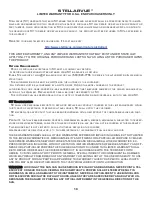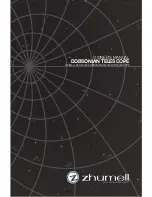
8
OBSERVING TIPS
Cool down:
Optics are affected by temperature changes, so it is not recommended to take a telescope from a
warm room to the cold night and immediately observe with it. The objective lens must settle down to the ambi-
ent temperature before it performs as it should. It is best to leave the telescope outside for a couple of hours to
let it cool down and acclimate.
Plan out your observing session:
Use a good planetarium pro-
gram to see what celestial objects are viewable in your location
when you are observing. Observe dimmer deep sky objects after it
gets completely dark and planets when they are as high in the sky
as possible. Planets and stars will be less affected by air turbulence
and atmospheric refraction when they are higher in the sky. This is
because you are looking through less atmosphere.
Dark adapting:
It takes at least 15 minutes for your eyes to adapt to the darkness so
you can see faint objects. If you use white light at night you will ruin your night vision.
The human eye is less impacted by red light, so always use a red observers flashlight
when observing. If a car approaches, avoid looking at the headlights. If your observing
session includes the moon you may want to do it last as it will seriously impact your
night vision. A good moon filter is recommended when observing the moon to filter out
80% of the moons glare. It is reflected sunlight, after all!
Record your observations:
It is fun to try your hand at sketching planets, clusters and other deep sky
objects. Check out the Astronomical League https://www.astroleague.org/ for more information.
Heat sources:
Avoid looking at planets, the moon, or close double stars when they are positioned above a
house roof or other structure that gives off heat. It will distort the views at higher powers.
Atmospheric Diffraction:
The atmosphere can cause your telescope to exhibit false
color. That color is not in the telescope, but above you. Moisture in the atmosphere may
act like prisms, and brighter objects will appear with a reddish color on one side and a
green-blue color on the other. This is the atmosphere, not your telescope.
Observing deep sky objects:
Deep sky objects like nebulae and galax-
ies can be very hard to discern for new hobbyists.The more experience
you have, the more of them you’ll be able to see. Avoid observing when
you are tired or after consuming alcohol or drugs. With time, you will be-
come more able to see these very low contrast, diffuse objects. Try using
averted vision, where you look to one side of the object where your eye is
more sensitive. If you are looking at a diffuse object and you are not sure
you are seeing it, lightly tap the side of the telescope and as the stars vi-
brate, so will the object. When observing deep sky objects, if you want to
focus the telescope better, focus on the brightest star in the eyepiece, not
the diffuse object. Finally, when observing objects like gobular star clus-
ters make sure you are not touching the telescope. Even a small vibration
can render dimmer stars invisible.
Comfort:
Dress warmly enough for the night air, if you are cold you will not see as much. This is particularly
true for your ears. Cover your ears and you will retain more body heat. Use a comfortable chair and position
yourself so you are not craning your neck or twisting your back. If you have a refractor that requires you to get
down on your knees, use a padded kneeling mat.
Putting it all away:
Always keep the telescope capped and/or covered when not in use. After a night under
the stars, bring your telescope inside and let it acclimate to the indoors. If dew has formed on your lens, uncap
both ends and let it air dry before putting it away. Do this in a room that is dry and relatively dust free. Putting
your telescope away wet can encourage mold growth and while that is rare, it is something you should
always avoid.
Globular Cluster




























